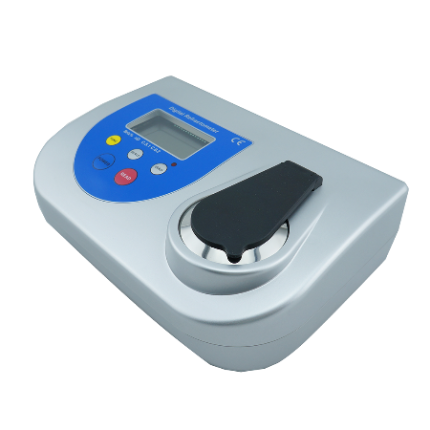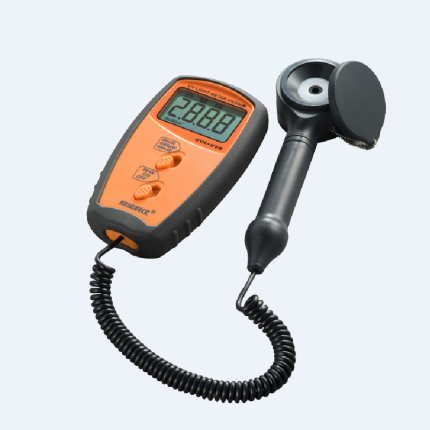Description
Overview
GAOTek Refractometer with Alarm (High Precision, Auto Shut Off) is an easy to carry, light weight and precise optical device designed for clinical applications such as measuring specific gravity of urine, total protein in serum or plasma, and refractive index. The Automatic Temperature Compensation feature of this device provides repeatable measurements on an easy to read scale. Three scales in one instrument allow for quick and easy measurements. This digital refractometer is able to automatically correct for differences in the temperature of the sample to a reference temperature, usually 68 °F (20 °C) and it also can automatically compensate for temperature differences within the range 41 °F to 104 °F (5 °C to 40 °C).
Key Features
- Automatic temperature compensation
- Automatic Shut Off after 3 minutes
- Alarm of low voltage & low power consumption
- Conversion between Centigrade and Fahrenheit degree
- Instantaneous reading
- Stainless steel sample plate
- Digital readout
- LCD display
- Only about 0.3 ml–0.5 ml sample needed
Technical Specifications
| Temperature Measurement Range | 32 °F – 104 °F (0 °C – 40 °C) |
| Precision of Measurement Temperature | 2 °F (±1 °C) |
| Measurement Temperature Resolution | 0.1 °F (0.1 °C) |
| Operation Temperature | 32 °F – 104 °F (0 °C – 40 °C) |
| Storage Temperature | 14 °F – 122 °F (-10 °C – 50 °C) |
| Operating Time | More than 8000 times per battery |
| Operating Humidity | Lower than 90 % RH |
| Operation Sea-Level | Lower than 2000 m |
| Dimension | 5.11 in × 2.75 in × 1.57 in (130 mm × 70 mm × 40 mm) |
| Weight | 0.33 lbs (150 g) |
| Power Supply | 1.5 V AAA+ |
Automatic temperature compensation
Automatic-temperature-compensation ensures that concentration reading of aqueous (water-based) solution will be accurate with respect to the sample’s temperature. This digital refractometer is able to automatically correct for differences in the temperature of the sample to a reference temperature, usually 68 °F (20 °C). It is well known that substantially all materials expend when heated (become less dense) and contract when cooled (become more dense). The speed of light in a liquid increases with temperature, and the refractive index therefore decreases. Although this thermal effect is small for solids, the change in density for liquids is substantial. For example, the reading for a sucrose solution will change by approximately 0.5 % Brix for each 10 °F (5 °C) change in temperature. So, a 10% Brix solution read at 108 °F (42 °C) would read 8 Brix on a non-temperature compensated instrument. Many hand-held refractometers are not temperature compensated and require the user to manually take temperature measurements and apply a correction. Other hand-held refractometers offer only rudimentary compensation in the range of 65 °F (18 °C) to 95 °F (35 °C). This digital refractometer can automatically compensate for temperature differences within the range 41 °F to 104 °F (5 °C to 40 °C). For the most accurate possible readings the instrument, the ambient temperature and the fluid should be in equilibrium within this temperature range. When testing a sample with a temperature that deviates a great deal from the temperature of the instrument it may be necessary to put the instrument and the fluid in the same environment for some time. A good rule is to wait approximately 30 minutes for each 10 °F (5 °C) difference in temperature in order to conduct measurement after keeping the instrument, fluid to be tested and environment at the same temperature.
| Model | Scales | Range | Divisions | Accuracy |
| URINE SP.G | 1.000 – 1.050 | 0.001 | ± 0.002 | |
| Clinical | SERUMP | 0 –12 | 0.1 | ± 0.2 |
| nD | 1.3330 – 1.3900 | 0.0001 | ± 0.0003 |
Operating Instructions
| PDR | Functions | Remarks | |
| ON/OFF Key | ON/OFF
|
Powers the instrument on and off. | Auto-off shuts down the instrument after 3 minutes of non-use. |
| READ Key | READ
|
Measurements: Apply approximately 0.3 ml~0.5 ml sample to the prism surface. Press the READ key. Within 1 second value is shown on the LCD display. | For best result, clean and wipe the prism with distilled water. |
| ZERO Key | ZERO
|
Zero-Check: Pressing ZERO key quickly to perform Zero-Check function. | Displays the nD value of the solution.
|
| Calibration: Pressing ZERO key to perform a zero calibration. To eliminate accidental calibrations, the key must be pressed for 3 seconds and the solution on the prism must be distilled water. | |||
| TEMP Key | TEMP | Press this key to transfer between °F and °C. | |
| SCALE Key |
SCALE
|
Active Scale: The scales can be switched between Brix, Refractive Index, and other scales by pressing the SCALE key until the desired scale is shown by the scale indicator at the bottom section of the LCD display. |
Precautions
- This refractometer is an electronic instrument, it can become damaged if dropped or handled in a rough manner.
- The prism is made of optical glass and is susceptible to scratches, do not apply any rough or abrasive material and take care when cleaning the prism.
- After each use, clean the prism & prism assembly with a soft cloth or tissue soaked in water and wipe off with a dry cloth or tissue.
- Do not hold the refractometer under a stream of water from a fau Do not splash it with or dip it in water.
- If the surface of the prism becomes coated with an oily solution or similar, it will repel test sample and affect readings. If this occurs, the prism should be cleaned with a weakened detergent or similar solvent.
- Do not use the instrument unless you have personal knowledge of calibration.
Calibration
- Calibration should be performed on a daily basis for optimum results and accuracy. For best results, perform calibration in a controlled environment of 68 °F (20 ℃) using distilled water of the same temperatur It is recommended to allow the instrument and the distilled water to reach temperature equilibrium with the controlled environment before calibration takes place.
- Apply approximately 0.3 ml~0.5 ml of distilled water to the prism surface, press the ZERO key for 3 secon When calibration is completed, “CAL” will be shown on the LCD display. To check the nD value of the zero setting for the distilled water, press the ZERO key, quickly, once. This data can be viewed at any time to show the last calibration value.
- When calibration is completed, gently wipe the prism using tissue paper.
Note:
- All the PDR models only can be calibrated with distilled water. Please don’t use any other calibration solution to calibrate the instru
- When there is any other solution (not distilled water) on the prism (sample plate), please DO NOT press the ZERO key or the instrument won’t work well again!



